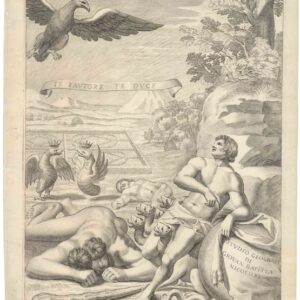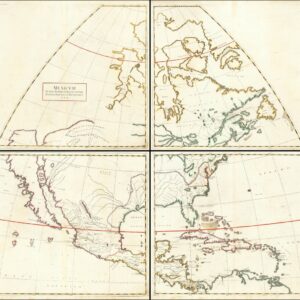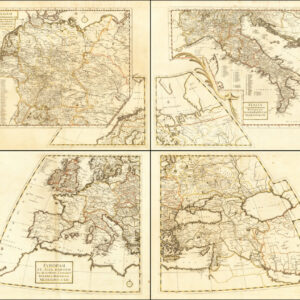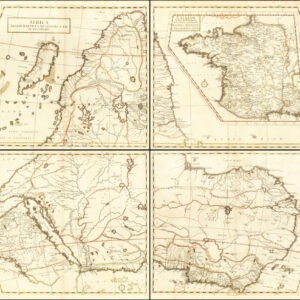Giovanni Battista Nicolosi (1610-1670), also known as Giovan Battista, was a Sicilian priest, geographer, and cartographer who worked for the Vatican’s Congregation for the Evangelization of Peoples (or Propaganda Fide) under Pope Gregory XV. Officially, the Fide office was established to promote missionary work across the globe. Still, the reality was that it constituted an essential office for the maintenance and dilation of the Church’s power in an ever-expanding world.
Arriving in the papal capital around 1640, Nicolosi studied letters, sciences, geography, and languages. In 1642, he published his Theory of the Terrestrial Globe, a small treatise on mathematical geography, and a few years later, his guide to geographic study was issued, a short treatise on cosmography and cartography. Both works reflected a Ptolemaic worldview, but his guide to geographic analysis would soon serve as an introduction to Nicolosi’s real magnum opus, Dell’ Ercole e Studio Geografico, first published in 1660. On the other hand, his Theory of the Terrestrial Globe brought Nicolosi to the attention of broader scientific circles. It earned him the Chair of Geography at the University of Rome. In late 1645, he traveled to Germany at the invitation of Ferdinand Maximilian of Baden-Baden, where he remained for several years until he returned to Rome. Here, Nicolosi was appointed chaplain of the Borghesiana in the Basilica of Santa Maria Maggiore. This honor was conferred on him by Prince Giovanni Battista Borghese, whom Nicolosi had tutored and in whose palace he had lived since 1651. Years later, Nicolosi would thank the prince for his generosity by dedicating his most seminal work to him.
A considerable collection of Nicolosi’s unpublished work exists in the Vatican and other national archives. This includes a large chorographic (i.e. descriptive) map of all of Christendom, commissioned by Pope Alexander VII, and a full geographic description and map of the Kingdom of Naples, which was sent to Habsburg Emperor Leopold I in 1654.
-
- Add to cart
- Rare Maps of Curiosities - Miscellanea
Studio Geografi di Giovan Batista Nicolosi.
- $575
- The wonderful and intriguing title page for Nicolosi's magnum opus, Dell’ Ercole e Studio Geografico.
-
- Add to cart
- Asia
Asia Ex Conatibus Geographicis Ioannis Baptistae Nicolosii S.T.D.
- $4,800
- Nicolosi’s gorgeous four-sheet map of Asia — the first to use a globular projection.
-
- Add to cart
- Mexico - Central & South America
Peru Descriptore [incl. Hispania Descripta Secundum Tres Coronas] Auctore Joanne Baptista Nicolosio.
- $3,900
- Nicolosi’s monumental and ground-breaking 4-sheet map of South America.
-
- Add to cart
- Africa
Africa Ioanne Baptista Nicolosio S.T.D. Sic Describente.
- $4,400
- A landmark map for the historical cartography of Africa.
-
- Add to cart
- World
[World] Continentem Dudum Notam Componebat & Continentem Noviter Detectam Componebat.
- $6,500
- The first printed map to use a full globular projection, and the first world map to accurately depict the course of the Rio Grande flowing into the Gulf of Mexico.
Archived
- Out of Stock
- North America, Texas and The West, United States
Mexicum In hac forma in lucem edebat Ioannis Baptistae Nicolosii S.T.D.
- From mysterious Vatican sources: The first accurate map of the Rio Grande and its tributaries!
- Read more
-
- Out of Stock
- World
[World] Continentem Dudum Notam Componebat . . . (and) Continentem Noviter Detectam Componebat
- Two paradigm-setting milestones in one map: the first printed map to use a full globular projection, and the first world map to accurately depict the course of the Rio Grande flowing into the Gulf of Mexico.
- Read more
-
- Out of Stock
- Europe
Europam et Asiæ partem Sic describere Conabar Ioannes Baptista Nocolosius S.T.D. Secondarily: Imperium Romano-Germanicum Secundum Decem Circulos Diuisum Describebat Ioannes Baptista Nicolosius S.T.D. & Italia Secundum Dominatus Descripta per Ioannem Baptistam Nicolosivm.S.T.D.
- Nicolosi’s impressive four-sheet map of Europe, with the Holy Roman Empire and late-Renaissance Italy.
- Read more
-
- Out of Stock
- Africa
Africa Ioanne Baptista Nicolosio S.T.D. Sic Describente
- A landmark map for the historical cartography of Africa.
- Read more
-


![Peru Descriptore [incl. Hispania Descripta Secundum Tres Coronas] Auctore Joanne Baptista Nicolosio.](https://neatlinemaps.com/wp-content/uploads/2024/05/NL-01973-composite_thumbnail-300x300.jpg)

![[World] Continentem Dudum Notam Componebat & Continentem Noviter Detectam Componebat.](https://neatlinemaps.com/wp-content/uploads/2024/04/NL-01969-composite_thumbnail-300x300.jpg)

![[World] Continentem Dudum Notam Componebat . . . (and) Continentem Noviter Detectam Componebat](https://neatlinemaps.com/wp-content/uploads/2021/07/NL-00940_Thumbnail-300x300.jpg)

